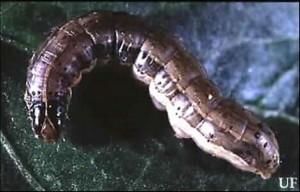Army worms are actively feeding in large numbers on bermudagrass hay fields in Washington and neighboring counties. If left unnoticed these foliage feeders will take a forage stand near harvest down to a few small stems in just a matter of days. Therefore producers need to scout heavily fertilized pastures and hay fields at least once/week, preferably twice/week.
Preferably scout late in the day or early evening, monitoring moth flights as well as actively feeding worms. Since only one worm per square foot is the threshold for treatment, it is important to check all the way around the field and any questionable spots in the field. Worms often leave one crop and enter another by field borders. Producers should also look for areas of the field appearing to have a different color or ragged appearance at a distance.
Cattle egrets certainly are a cause for alarm and investigation. Often by the time the egrets have found worms, the damage is already severe in at least a portion of the field. Therefore it is important to get down and part the grass in several spots and look closely for worms. They usually will fall to the ground when you do this. It is also important to monitor the size and species of worms to know which product and the amount needed to control the worms present.
Check days-to-harvest restrictions on the label of all products considered for use. Remember it is very difficult to kill big worms, so early detection is best. If large numbers of moths are fluttering close to the ground around dusk, begin checking that area of the field more frequently (2-3 times/week). These moths are laying eggs which will hatch large numbers of small worms. Depending on the product used, spraying late in the day may kill both actively feeding worms and the moths producing the next generation of worms. The high cost of fertilizer is a big incentive for early detection and treatment to keep losses at a minimum.
Consider developing a strategy for worm management. If the hay-field is a week to ten days from harvest, early harvest may be the best option to simply remove the food source for the worms. If harvest is several weeks away and worms are still small (>1/2 inch), a product with a 10 to 14 day residual protection such as Dimilin or Intrepid may be the best option. If worms are large (<1/2 inch), then Lannate or Nudrin may be the best option for a quick knock down. Remember early detection provides more control options and reduces expensive losses. For more information on controlling armyworms and other insects in pastures down load the UF Fact Sheet: Insect Control in Pasture.
Andy Andreasen, Washington County Extension Director
- November 2025 Weather Summary & Winter Outlook - December 5, 2025
- Friday Feature: The History of Beekeeping - December 5, 2025
- Friday Feature:Malone Pecan Festival Tractorcade - November 21, 2025

